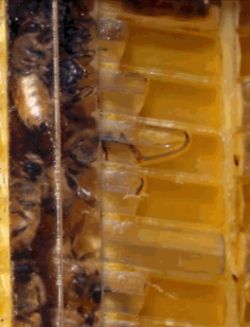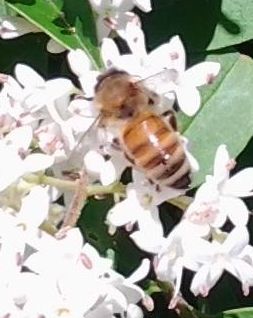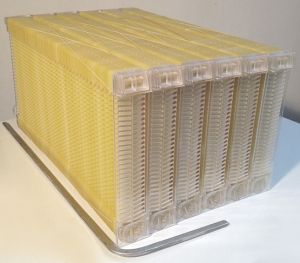
Publisher:
Bonnie King
CONTACT:
Newsroom@Salem-news.com
Advertising:
Adsales@Salem-news.com

~Truth~
~Justice~
~Peace~
TJP
Feb-23-2015 21:49


 TweetFollow @OregonNews
TweetFollow @OregonNews
Flow Beehive Crowdfunding Beats Goal By 3,000%
Bonnie King Salem-News.comToo good to be true? Flow Hive invention delivers honey on tap directly from the hive.
 The newly-invented Flow Hive delivers honey straight from the hive! Photo: honeyflow.com |
(SALEM, Ore.) - For the first time ever, there may be an easier way to extract honey from the hive. A father-son team, Stuart and Cedar Anderson, from Australia has been perfecting their idea for ten years, and it's been in use in experimental bee yards for three years.
"Flow™ is the most significant innovation in beekeeping since 1852,” said Cedar Anderson.
The success of their progressive beehive brought them to the point that they are ready for investors, and so they began a Crowdfunding campaign yesterday, asking for $70,000.
In ONE day, they raised $2,155,661 USD, which is 3,080% of their goal, with 41 days left (campaign closes April 5). That's something to buzz about!
The Crowdfunding campaign was clearly brilliant. They offer several options for supporters. For instance, for $350, supporters will receive their own Flow Full frame kit to fit into a Langstroth 8 frame super (no bees included!).

If you already have hives, they explain how to modify your boxes using only 2 cuts to fit the Flow frames. Depending on the size of your existing hive, three or four Flow frames may be placed in-between your traditional frames.
"We are blown away with the response!" commented co-inventor Cedar Anderson. "Some things appear sold out, but we are creating new options as we speak."
Is this Hive for Real?
Indeed it is. This isn’t just a concept, these special frames apparently really work. The bees fill the pre-fab cells with honey and when they are full, the beekeeper turns a switch which shifts the cells apart and the honey drains down and out. No bees are harmed in this form of extraction, and there is no mess or clean up.
 Cedar and Stuart Anderson |
Honey is captured straight out of the hive, without even opening the hive. That’s right. These new-fangled frames actually stay in place, and when each is full of honey, the beekeeper decides when to drain it by turning a tap, and releasing the honey into a jar.
This hive invention may be “the beekeeper's dream”, but it has many traditionalists skeptical. Of course it’s a great idea, and could be a great gimmick for the hobbyist beekeepers, but what is the real potential for high end production?
"In 2014 I had the pleasure of testing the Flow frames,” commented John Gates, BC Ministry of Agriculture.
“The bees quickly accepted the frames and in less than 2 weeks stored and capped 40 lbs. of honey. I must say it was quite exciting to see the first bit of honey appear at the outlet, then make its way down the tube into the jar. Mesmerizing.” Gates has been beekeeping since 1974.
In regard to the savings of time and energy, Michael Bush, author of Beekeeping Naturally (and one of USA’s most famous beekeepers) said, “Mind Blowing...It's not very often something is so revolutionary as to blow my mind...Saving 20% of harvest labor is not trivial, 40% is amazing, 60% is revolutionary. But 95%, that’s Mind Boggling!”
Where Does Honey Come From?
In order to best appreciate the end product, honey, it is important to understand how honey is made.
A honeybee colony contains one Queen (a fertile female), a few thousand drones (fertile males), and tens of thousands of Worker bees (sterile females). Altogether, a hive may have 60,000 honey bees under one roof. Worker honey bees are all female, and they have every job description in the hive. As they mature, their jobs evolve.
Older workers are the ones that fly out from the hive and forage, bringing nectar back to the hive. Using its tongue, a straw-like proboscis, the honey bee drinks the sweet liquid from nectar-rich blossoms and stores it in a special stomach called the honey stomach.

Once in the honey stomach, enzymes break down the nectar’s complex sugars (sucrose) into two six-carbon sugars (glucose and fructose), which are less prone to crystallization. This is called inversion.
The worker bee may visit hundreds of flowers, until her honey stomach is full. Bonus: While gathering nectar for their survival, honeybees inadvertently transfer pollen grains from one flower to another, pollinating crops as she flies from one blossom to the next.
When she’s full, the worker bee heads back to the hive and passes the already modified nectar to one of the younger “hive bees” via regurgitation to finish the work of turning it into honey. Then she heads out to forage some more.
The hive bee breaks down the sugars even further, then regurgitates the inverted nectar into a cell of the honeycomb. To remove the extra water content from the honey, hive bees beat their wings furiously, fanning the cells of nectar until the sugars thicken into honey, leaving only about 18-percent water in honey.
Then the hive bee caps the cell with beeswax, and she goes on to the next.
One worker produces only 1/12th of a teaspoon of honey in her lifetime, so it takes thousands of bees working together from spring to fall to produce at least 60 pounds of honey to sustain the colony through a typical winter. Beekeepers always leave honey for the bees’ consumption, or they will starve.
Comparing FLOW with Traditional Extraction
 Flow Hive |
Traditionally, after all the cells are packed with honey and sealed with wax, the beekeeper “takes off” the honey by removing the full box from the hive and replacing it with an empty, with all new frames.
This new invention removes that entire process.
With the FLOW hive, when the honey is ready to harvest, the beekeeper would simply trek out to the hives with jars to fill, instead of what they do today, a very physical undertaking:
Firing up a smoker to sedate the bees, breaking the seal on the top lid with the hive tool and brushing the bees aside so you can lift the super, full of frames heavy with honey, off the rest of the hive and transport to be extracted.
Honey is then extracted by taking the frame and using a hot uncapping knife, slicing the capping off each frame and sliding them into an extractor which spins out the honey using centrifugal force. It’s a process beekeepers know well. After the honey is collected, it is strained to remove bits of wax and parts of bees, then put into jars and shared with others.
No doubt, there is an ample amount of clean up following the extraction process, and plenty of work in prepping the frames to be used again. Still, it is not something most large scale beekeepers complain about. It’s been a fact of life….for a very long time.
After they experience the Flow frames, they may feel differently. With only a turn of the tap, beekeepers can sit back and watch the honey jars be filled. What a shock to the system!
Honeybees Make More Than Honey
Honey is a treasure from nature. It’s a stable food that naturally resists molds, fungi and other bacteria, allowing it to last for years without refrigeration. It may granulate, but can be liquefied easily and without losing any of its inherent qualities.
Honey is a bi-product of the beekeeping industry, not the mainstay. So what’s more important than honey? Pollination.
Many beekeepers do move their bees into high honey producing areas, especially in the summer months, but for most commercial beekeepers, pollination is what bees do best.
According to the American Beekeeping Federation, some crops, including blueberries and cherries, are 90-percent dependent on honey bee pollination; one crop, almonds, depends entirely on the honey bee for pollination at bloom time.
My father, Alan Ehry, was one of the first beekeepers to move bees from Oregon into the almonds in California. Today, more than a million colonies are used every year to pollinate the almonds.
If he were still here, I know he would be intrigued by this new invention and their claim that “It’s far less stress for the bees and much, much easier for the beekeeper.”
My dad loved his bees, and I think he would have liked this idea...making it easier for all involved. Hey, it’s worth a shot.
One thing’s for sure: Beekeeping is a labor of love, no matter how your honey flows.
Crowdfunding Campaign:
http://bit.ly/1zZlnj8
http://www.honeyflow.com/
 |
Articles for February 23, 2015 | Articles for February 24, 2015

googlec507860f6901db00.html




Terms of Service | Privacy Policy
All comments and messages are approved by people and self promotional links or unacceptable comments are denied.
[Return to Top]
©2025 Salem-News.com. All opinions expressed in this article are those of the author and do not necessarily reflect those of Salem-News.com.